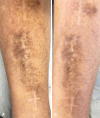Cutaneous manifestations of diabetes mellitus: a narrative review
- PMID: 40105573
- PMCID: PMC11908747
- DOI: 10.31744/einstein_journal/2025RW1193
Cutaneous manifestations of diabetes mellitus: a narrative review
Abstract
Diabetes mellitus is a highly prevalent human endocrine disorder. Skin lesions are reported in approximately one-third of all diabetes mellitus patients. The clinical presentation and frequency vary according to the subtype of diabetes mellitus, metabolic control, and clinical course, with certain skin diseases occurring before diagnosing hyperglycemia. In this regard, the correct definition of cutaneous manifestations associated with diabetes mellitus can help define the etiology of hyperglycemia as well as the need to optimize glycemic control. In this narrative review, the most common cutaneous diseases observed in diabetes mellitus are discussed, including pruritus, acanthosis nigricans, necrobiosis lipoidica, bullosis diabeticorum, scleroderma diabeticorum, granuloma annulare, diabetic dermopathy, skin reactions due to device use, diabetic foot ulcers, recurrent cutaneous infections in diabetes mellitus and other dermatoses associated with hyperglycemia. The epidemiology, pathophysiology, differential diagnosis, and treatment of this disease are discussed. Therefore, knowledge and recognition of the most common dermatological lesions in patients with diabetes mellitus are essential for both endocrinologists and primary care physicians.
Figures




References
-
- Jaacks LM, Siegel KR, Gujral UP, Narayan KM. Type 2 diabetes: A 21st century epidemic. Best Pract Res Clin Endocrinol Metab. 2016;30(3):331–343. - PubMed
-
- Perez MI, Kohn SR. Cutaneous manifestations of diabetes mellitus. J Am Acad Dermatol. 1994;30(4):519–531. - PubMed
-
- Lima AL, Illing T, Schliemann S, Elsner P. Cutaneous Manifestations of Diabetes Mellitus: A Review. Am J Clin Dermatol. 2017;18(4):541–553. - PubMed
-
- Hines A, Alavi A, Davis MD. Cutaneous Manifestations of Diabetes. Med Clin North Am. 2021;105(4):681–697. - PubMed
-
- International Diabetes Federation (IDF) IDF Diabetes Atlas. 10th. Belgium: IDF; 2021. [cited 2023 Mar 21]. https://www.diabetesatlas.org

